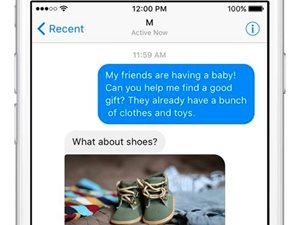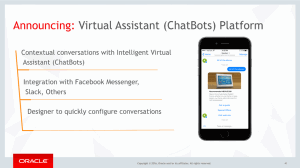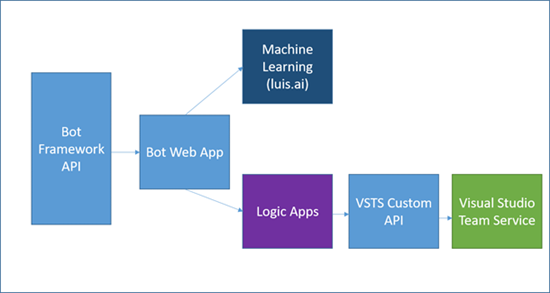Are Conversational Systems the Future of Web Interface?
The new wave of AI-assisted services like Apple Siri, Microsoft Cortana, Facebook’s M, Alexa-powered  Amazon Echo, and Google Home have already started changing how we browse the web. This is a revolutionary change in how people interact with computers. Microsoft's CEO Satya Nadella has once famously said: "It's technology that's inevitable," and referred to the development of chatbots as a way to create “conversation as a platform.” Just like many other technology trends, the consumer market, initially, was the target for conversational systems but today, it becomes an emergent software category that has clear business use cases and that is embedded in a new set of cloud platform services.
Amazon Echo, and Google Home have already started changing how we browse the web. This is a revolutionary change in how people interact with computers. Microsoft's CEO Satya Nadella has once famously said: "It's technology that's inevitable," and referred to the development of chatbots as a way to create “conversation as a platform.” Just like many other technology trends, the consumer market, initially, was the target for conversational systems but today, it becomes an emergent software category that has clear business use cases and that is embedded in a new set of cloud platform services.
Conversational systems have been identified by Gartner as one of top strategic technology trends for 2017. The market research firm ranges conversational systems from bidirectional text or voice conversations (simple questions about the weather) to more complex interactions such as collecting oral testimony from crime witnesses to generate a sketch of a suspect. The backend data analysis and machine learning algorithms make up the foundation for these products. All the major cloud players are steering their ships in the very same direction where they muscle up in the battle for AI supremacy to exploit this new technology.
Facebook
Facebook has been shifting Messenger from its core of being a basic IM app to an important real-time  business application platform. Last year, the second most popular app on iOS, with 1.2 billion users every month announced the Messenger Platform (Beta) with bots and Send / Receive API, and this year, at Facebook’s recent F8 developer conference, introduced Messenger Platform 2.0, a new suite of tools that gives users the ability to build richer experiences, get discovered, and extend the conversational, visual and social capabilities of their bots. With the new enhancements, Facebook enables businesses to deliver more personalized and seamless omnichannel experience. For example, when someone is communicating with a business through a bot in Messenger, the experience could be more personalized if the business recognizes that the person is an existing customer in their Facebook app (e.g. a website or mobile app with Facebook Login). Facebook provides an API for retrieving IDs for the same person across apps and bots in Messenger that are owned by the same business. The company also introduced a new surface called Discover to help users intuitively browse and find the best bots, places, and businesses in Messenger.
business application platform. Last year, the second most popular app on iOS, with 1.2 billion users every month announced the Messenger Platform (Beta) with bots and Send / Receive API, and this year, at Facebook’s recent F8 developer conference, introduced Messenger Platform 2.0, a new suite of tools that gives users the ability to build richer experiences, get discovered, and extend the conversational, visual and social capabilities of their bots. With the new enhancements, Facebook enables businesses to deliver more personalized and seamless omnichannel experience. For example, when someone is communicating with a business through a bot in Messenger, the experience could be more personalized if the business recognizes that the person is an existing customer in their Facebook app (e.g. a website or mobile app with Facebook Login). Facebook provides an API for retrieving IDs for the same person across apps and bots in Messenger that are owned by the same business. The company also introduced a new surface called Discover to help users intuitively browse and find the best bots, places, and businesses in Messenger.
Oracle
As I reported last week here at CMS-Connected, Oracle made significant enhancements including chatbots and artificial intelligence with enhanced mobile, video and messaging capabilities. With the new release, marketers are now able to customize responses during the conversations powered by an Oracle-connected chatbot on Facebook Messenger or Amazon Alexa. The technology is designed to detect the human’s intent and context therefore, if the conversation between customer and chatbot becomes complicated, the tool will automatically hand off to a live agent to avoid any potential frustration. According to Oracle, the capabilities also provide differentiated customer self-service experiences. On top of these, the new innovative chatbot capabilities are also expected to improve sales productivity as they automate common sales tasks such as account search, transaction creation, and updates.
artificial intelligence with enhanced mobile, video and messaging capabilities. With the new release, marketers are now able to customize responses during the conversations powered by an Oracle-connected chatbot on Facebook Messenger or Amazon Alexa. The technology is designed to detect the human’s intent and context therefore, if the conversation between customer and chatbot becomes complicated, the tool will automatically hand off to a live agent to avoid any potential frustration. According to Oracle, the capabilities also provide differentiated customer self-service experiences. On top of these, the new innovative chatbot capabilities are also expected to improve sales productivity as they automate common sales tasks such as account search, transaction creation, and updates.
“In a world where not everyone will download your mobile app but are using Facebook Messenger and Alexa-driven devices, chatbots are a way for you to play in these new conversational media,” Oracle group VP product management, Steve Krause, told attendees. “The reason this matters is because of things like Messenger, Alexa, Google home – these are starting to happen and we’re only at the beginning of this trend. This is about enabling you to be there as a brand as interaction happens.”
Apple
Since the introduction of Siri about five years ago, we have consistently seen Apple in the news making a  significant number of acquisitions and product enhancements to leverage its AI capabilities.
significant number of acquisitions and product enhancements to leverage its AI capabilities.
To make Siri better understand human speech and give it a more competitive edge, Apple acquired VocalIQ, and it bought Perceptio to protect consumer data by keeping data local to each device instead of uploading user data to the cloud. Last year, it snapped up Emotient, as its technology can read facial expressions to determine a person's mood. To process the data from iPhones in real time, Apple also bought Tuplejump, focused on applying deep learning to large data sets. Of all its recent acquisitions, Turi is arguably the most interesting one as with that deal, Apple allowed developers to build apps through deep learning that could scale for many users. The idea is similar to Google's TensorFlow, the open-source machine-learning library.
Google
Google has acquired 11 private AI startups up to date. The acquisition of DeepMind, with a price tag estimated at $660 million marked one of the largest acquisitions among the M&A deals in the AI area. DeepMind’s specific focus on improvements in general AI research has helped Google apply the research to its business process to beef up its AI capabilities. Another main drive behind these acquisitions was developing Google’s Home to have a leg up on the competition against the virtual personal assistant market leader, Amazon's Alexa. To that point, the tech behemoth acquired three companies specialized in image recognition; DNNResearch which is focused on deep learning, image search, and facial recognition; Moodstocks which is specialized in image recognition for smartphones; Vision Factory which is used for improving accuracy and speed in object and text recognition.
Microsoft
Microsoft has also waded into the foray for conversational software by launching its consumer services like Cortana, and Tay and cloud services like Azure ML, Cognitive Services, and the Bot Service. Last year, the vendor also introduced the Bot Framework (see the graph below) that allows developers to create intelligent bots to interact with users in a natural way.

The tech titan also has been beefing up its artificial intelligence capabilities through acquisitions. In February, Microsoft confirmed that it has acquired SwiftKey, which makes predictive keyboard software that learns users’ typing habits and adapts accordingly, for $250 million. This acquisition was followed by the acquisition of a messaging app developer, Wand Labs in June. The deal was part of Microsoft’s strategy for Conversation as a Platform, which Satya Nadella introduced at the Build 2016 conference in March. Lastly, in August, the company also signed an agreement to acquire Genee, an artificial-intelligence-powered scheduling service in an effort to integrate its smart assistant Cortana with Office 365 apps.
Amazon
Gartner predicts that 75% of US households will have smart speakers like Amazon Echo or Google Home by  2020. As being a pioneer in this space, Amazon has been enjoying the increase in the user adoption of Amazon’s Echo Alexa, which represents the beacon of today’s smart home, allows consumers to order the ‘usual’ pizza or purchase more Tide dish detergent from a local delivery company. This IoT-connected, voice-activated, convenient and efficient household assistant is capable of ‘doing’ commerce with a simple vocal command and turning off lights to save energy at the same time. Until Amazon’s annual event re:Invent 2016, the only way developers could access Amazon’s conversational algorithms was through Alexa devices but during the event, AWS launched several new AI services that will provide the computational foundation for voice, text and image recognition applications.
2020. As being a pioneer in this space, Amazon has been enjoying the increase in the user adoption of Amazon’s Echo Alexa, which represents the beacon of today’s smart home, allows consumers to order the ‘usual’ pizza or purchase more Tide dish detergent from a local delivery company. This IoT-connected, voice-activated, convenient and efficient household assistant is capable of ‘doing’ commerce with a simple vocal command and turning off lights to save energy at the same time. Until Amazon’s annual event re:Invent 2016, the only way developers could access Amazon’s conversational algorithms was through Alexa devices but during the event, AWS launched several new AI services that will provide the computational foundation for voice, text and image recognition applications.
Hubspot
Speaking of Amazon Lex, HubSpot is one of the early adopters as the company used it to create a chatbot that connects to multiple systems including HubSpot and Google Analytics and provides conversational access to marketing information.
How Enterprises Benefit from Conversational, Bot-Powered Services
This technology is designed to help businesses maintain the feeling of connection as well as eliminate wait times, dropped calls, and lost tempers. As Parthasarathi V., Lead Consultant for the Workplace Reimagination practice at TCS Digital Enterprise, stated, “Through conversational software, an enterprise can simplify and reimagine business processes, and reduce and automate workflows through context-aware intelligence systems. It also enables users and systems to have meaningful interactions, working in tandem to meet business goals.”
Now that we made sure that conversational systems are not a fad, let’s discuss why they are important for businesses across industries. Here are some significant business outcomes:
Productivity. First off, whether it is about some account details or the level of the inventory, reaching accurate information in the most efficient manner when needed is getting more and more critical for businesses. Not only obtaining the information but also automation and delegation of day-to-day tasks directly contribute to productivity and efficiency of workforces. Therefore, having a trustworthy assistant hiding in your pocket or embedded in devices can increase productivity while reducing the time spent on searching information or connecting with people as well as the loss of accuracy.
Scalable customer service. Take a moment and imagine a scene at the airport where a flight has been canceled just before the departure time, and the airway company has only two personnel in the field to calm down 250 frustrated passengers while booking their next flight at once. In this scenario, if the company had been able to deliver the optimized chatbot experience for rapidly arranging stranded passengers’ next flights, their personnel could have dealt with passengers’ frustration through a better human interaction.
More relevant customer service. To me, the greatest benefit of these AI-driven conversations is that brands can pick up instantly what their customers need even before they know or tell through their strong understanding of context. Yes, the customer can be informed about approximately when their most recent order will arrive via an order confirmation email from the retailer, but the conversation on, say a messaging app, flows seamlessly between customer and support. Additionally, this on-going conversation is not only more natural and personal but also represents the opportunities for brands like cross-sell, social sharing, solicit input, and so on.
Omnichannel customer experience. Today, 91% of customers want to pick up where they left off from one channel to the next, disconnection between departments and channels is not something today’s consumer really wants to tolerate and especially millennials are not really known for their high tolerance and loyalty. In other words, customers should not feel any loss of context when they switch from one channel to another. To that point, it is critical that all your channels, whether voice, text, social or apps, should be conversational in nature with each other.
Globalization. San Francisco-based VoiceBase tapped into the Google Cloud Speech API to build a SaaS speech analytics platform that turns voice data into useful information that can help companies automate and gain insight into their operations. The company transcribes and processes millions of recordings every month for contact centers, conferencing service providers, video and education platforms, telecom providers and Fortune 500 companies. The service does not only provide transcripts but also offers tools to solve complex business problems — such as analyzing audio files and transcripts from call centers to predict the level of customer churn, and letting users search the timeline of a recording to find and play precise parts of a conference call, webinar, educational lecture, podcast or video interview.
Brand personality. Whether it is a chatbot, a virtual assistant, or a voice-activated assistant, the level of personalization that these technologies can deliver is not limited to only customers. Another important aspect of the business is brand identity, and cutting out human interaction can easily spoil it. However, the vendors are enhancing their platforms to deliver human-like responses, so brands can train their chatbots to have the same voice and tone, just like train their customer-facing employees, for instance, launched an external API for developers, which Taco Bell has already publicized with its in-the-works ‘Tacobot‘, apparently capable of taking your order and doing so with ‘personality’. This is one of the areas of conversational systems for exploration by businesses.
My POV
Chatbots aren’t new, yet one of the earliest chatbots, ELIZA, was published in 1966 by tapping into the same pattern-matching foundation with many modern chatbots. Since then, developers and data scientists have been working on computer systems that can recognize images and comprehend speech without the loss of accuracy and the nature of the conversation. Today, although the field is still immature, all of those efforts started to come to fruition, as many more enterprises are making strategic bets on conversational, bot-powered services as the next vehicle for business interactions to drive better customer and employee engagement.
Another important trend tied to conversational systems is that messaging apps are becoming even more popular and sitting in the center of those systems. Although in 2008, with the explosion of brand mobile apps, so many brands launched their own apps but this trend seems to settle in. Today six of the top 10 global apps are messaging apps, used by 1.4 billion people worldwide and growing by 12% annually. Facebook’s WhatsApp and Messenger are leading the pack. China’s WeChat has 10 million business accounts (called “official accounts”), which its 650 million monthly users can interact with in ways similar to how they’re interacting with their friends. Therefore, building a bot with messaging apps do not only make brands' experience available on all channels that Messenger incorporates with but also removes the friction of your users having to download one more app, on top of all the apps they already have and may not use.

Venus Tamturk
Venus is the Media Reporter for CMS-Connected, with one of her tasks to write thorough articles by creating the most up-to-date and engaging content using B2B digital marketing. She enjoys increasing brand equity and conversion through the strategic use of social media channels and integrated media marketing plans.